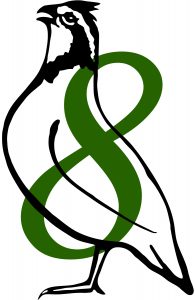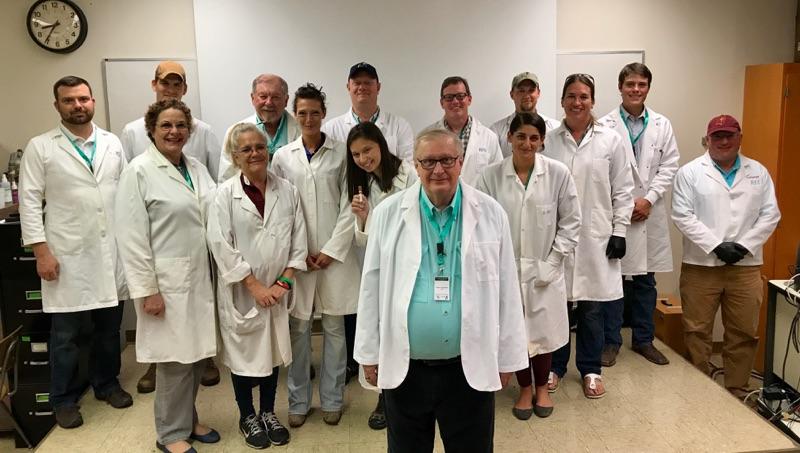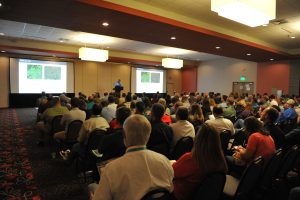This year our team was lucky enough to be able to attend the Quail 8 Symposium in Knoxville, Tennessee. It was  held in conjunction with the annual meeting of the National Bobwhite Technical Committee and heavily supported by the National Bobwhite Conservation Initiative, the Tennessee Wildlife Resources Agency and the University of Tennessee, Knoxville (a nice job to all involved!). The Quail Symposium Series is held only once every 5 years. It is said that the bobwhite quail is one of the most studied animals in the annals of wildlife science. I don’t know how to verify that, but in this year’s symposium series there are 94 manuscripts from 72 authors. Most of the general public and most quail hunters do not know about all this work. But it is the job of project leaders like me all across the bobwhite’s range to read, participate and understand the latest in quail science and get it to you.
held in conjunction with the annual meeting of the National Bobwhite Technical Committee and heavily supported by the National Bobwhite Conservation Initiative, the Tennessee Wildlife Resources Agency and the University of Tennessee, Knoxville (a nice job to all involved!). The Quail Symposium Series is held only once every 5 years. It is said that the bobwhite quail is one of the most studied animals in the annals of wildlife science. I don’t know how to verify that, but in this year’s symposium series there are 94 manuscripts from 72 authors. Most of the general public and most quail hunters do not know about all this work. But it is the job of project leaders like me all across the bobwhite’s range to read, participate and understand the latest in quail science and get it to you.
Translocating Wild Quail
I am often asked why we do not actively translocate bobwhite quail like we have done with turkeys, deer, bears and other species to speed up re-population efforts. The truth is we have tried it here in Virginia back in the late 1990s. And it has been tried in multiple states with varying degrees of success (or failure in many cases). Over a 50- year period about 900 wild turkeys were relocated in Virginia. This took a lot of work and it was successful in many cases.
One of the first differences between quail and turkeys is that there were millions of acres of turkey habitat into which to transport turkeys. Another big difference shown by modern research is that it takes far more quail to engender a response than it does turkeys, or deer, or bears. The synthesis of the best information available today states that in order to successfully repopulate an area with quail: 1) the area must be at least 1,500 acres of very good quail habitat; 2) target bobwhite population at the end of the translocation period should be about 800 quail. This is accomplished by translocation of 100 wild quail per year for 3 years and then hoping for good reproduction from those translocated individuals, 3) some wild quail should be present on the site before any translocation occurs, 4) and source populations should be disease free and obtained from as close a source as possible (Martin et.al – 2017).
There is more, but I hope this illustrates that translocating wild quail effectively will be an intense process that will only work well in select settings. We are exploring the possibilities in Virginia, and it is in our future, but we will do it right or not at all.
Population Assessment
Many landowners struggle with assessing their quail populations. Traditionally, some form of June whistling male counts are used to track trends. In the last decade the practice of using fall morning covey counts became the gold standard. This method allowed a very solid assessment just prior to hunting season, and could be used to adjust harvest levels on individual properties.
The fall method tends to be more time and labor intensive than June whistle counts. A study was conducted to assess whether June whistling male counts could be correlated to fall density (Sisson and Terhune. 2017). The study showed that: “Peak number of males heard in spring and number of coveys heard in autumn were strongly correlated for all points combined; indicating that spring whistle counts are a reliable tool for assessing bobwhite relative abundance on sites where autumn covey counts are precluded or the information is needed before autumn.”
Landowners who are interested in learning how to do June call counts on their properties should contact us. It is fairly simple and we can talk you through it.
Finding Quail in the Field
One often hears quail hunters lamenting how tough it is to find quail, even in areas where they know there are quail. A study using radio-collared quail coveys, led by Tall Timbers Research Station, showed that, on average, good pointing dogs only cover enough area within a given property to have a chance of detecting about 52% of available coveys (Terhune et al. 2017). The overall probability of a dog finding a covey is about 38%. I interpret this to mean hunters should more thoroughly cover the grounds they hunt, particularly when they believe “quail should be there.”
I understand to train and keep a dog in birds now-a-days often means hunting pen-raised quail. But a study conducted in Kentucky suggests that when hunters have become accustomed to hunting pen-raised quail, their expectations when hunting wild quail may be unrealistic (Orange et al. 2017). Using radioed wild coveys and pen-raised coveys on public lands, it was demonstrated that hunters found only 29% percent of wild coveys. And they were 8.6 times more likely to find pen-raised coveys. This suggests that hunters pursuing wild quail must be educated about the differences in detection rates and expectations should be realistic to maintain support for wild quail restoration on public hunting lands.
Eye Worms

And what about eye worms? No, they do not look like eyes, but they are often found in a quail’s eyes, especially in Texas. Over the last few years there has been a great deal of publicity surrounding eye worms being detected at high levels in Texas quail. Our quail hunters often asked me about eye worms in Virginia’s quail, so we reached out to Dr. Dale Rollins and his team in Texas to help us examine some Virginia quail. Their study, surprisingly, did find some eye worms in Virginia’s quail (Kubečka et al. 2017). Eye worms were detected at rates of 59.1% in Texas, 52.1% in Oklahoma, 14.8% in Virginia (4 out of 27 submitted – low sample size) and 1.6% in Alabama. They were non-existent in other states tested. There were also many more eye worms per quail in Texas. Of the 4 that had eye worms in Virginia, only 1 or 2 worms were detected, where as many 109 were detected in one Texas quail. While at Quail 8, Dr. Rollins team (THANKS!) gave us a hands-on class in how to examine quail for eye worms and we will be examining about 250 more heads collected by hunters here last year But currently we do not believe eye worms are an issue in Virginia. Texas is still working on the situation there.
… just some of what we learned at Quail 8 while working 12 to 14 hour days on behalf of bobwhites.

Sources all came from this year’s Quail 8 Proceedings.
- Martin, R. Applegate, T. Dailey, M. Downey, B. Emmerich, F. Hernández, M. McConnell, K. Reyna, R. Ruzicka, and T. Terhune, II. 2017. Translocation as a population restoration technique for northern bobwhites: a review and synthesis.
- Clay Sisson and Theron Terhune, II. 2017. Use of spring whistle counts to predict northern bobwhite relative abundance.
- Terhune, II, D. McGrath, S. Wood, and J. Martin. 2017. Hunter-Covey interactions using pointing bird dogs.
- Orange, J. Yeiser, D. Baxley, J. Morgan, and B. Robinson. 2017. Evaluating hunting success of pen-reared and wild northern bobwhite in a reclaimed Kentucky mineland.
- Kubečka, A. Bruno, and D. Rollins. 2017. Geographic survey of Oxyspirura petrowi among wild northern bobwhite in the United States.






